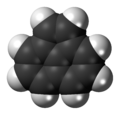This is the current revision of this page, as edited by Prenestina (talk | contribs) at 20:41, 25 February 2024 (→Toxicity). The present address (URL) is a permanent link to this version.
Revision as of 20:41, 25 February 2024 by Prenestina (talk | contribs) (→Toxicity)(diff) ← Previous revision | Latest revision (diff) | Newer revision → (diff) Not to be confused with Acenaphthene.
| |||
| Names | |||
|---|---|---|---|
| Preferred IUPAC name Acenaphthylene | |||
| Other names
Cyclopentanaphthalene Acenaphthalene Tricyclododeca-1(12),2,4,6,8,10-hexaene Tricyclododecahexaene | |||
| Identifiers | |||
| CAS Number | |||
| 3D model (JSmol) | |||
| ChEBI | |||
| ChemSpider | |||
| ECHA InfoCard | 100.005.380 | ||
| PubChem CID | |||
| UNII | |||
| CompTox Dashboard (EPA) | |||
InChI
| |||
SMILES
| |||
| Properties | |||
| Chemical formula | C12H8 | ||
| Molar mass | 152.196 g·mol | ||
| Appearance | Yellow crystals | ||
| Density | 0.8987 g cm | ||
| Melting point | 91.8 °C (197.2 °F; 364.9 K) | ||
| Boiling point | 280 °C (536 °F; 553 K) | ||
| Solubility in water | Insoluble | ||
| Solubility in ethanol | very soluble | ||
| Solubility in diethyl ether | very soluble | ||
| Solubility in benzene | very soluble | ||
| Solubility in chloroform | soluble | ||
| Thermochemistry | |||
| Heat capacity (C) | 166.4 J mol K | ||
| Enthalpy of fusion (ΔfHfus) | 186.7 kJ/mol | ||
| Enthalpy of vaporization (ΔfHvap) | 69 kJ/mol | ||
| Enthalpy of sublimation (ΔfHsublim) | 71.06 kJ/mol | ||
| Hazards | |||
| GHS labelling: | |||
| Pictograms |  
| ||
| Signal word | Danger | ||
| Hazard statements | H302, H310, H315, H319, H330, H335 | ||
| Precautionary statements | P260, P261, P262, P264, P270, P271, P280, P284, P301+P312, P302+P350, P302+P352, P304+P340, P305+P351+P338, P310, P312, P320, P321, P322, P330, P332+P313, P337+P313, P361, P362, P363, P403+P233, P405, P501 | ||
| Flash point | 122 °C (252 °F; 395 K) | ||
| Related compounds | |||
| Related compounds | acenaphthene | ||
| Except where otherwise noted, data are given for materials in their standard state (at 25 °C , 100 kPa).
| |||
Acenaphthylene, a polycyclic aromatic hydrocarbon is an ortho- and peri-fused tricyclic hydrocarbon. The molecule resembles naphthalene with positions 1 and 8 connected by a -CH=CH- unit. It is a yellow solid. Unlike many polycyclic aromatic hydrocarbons, it has no fluorescence.
Occurrence
Acenaphthylene occurs as about 2% of coal tar. It is produced industrially by gas phase dehydrogenation of acenaphthene.
Reactions
Hydrogenation gives the more saturated compound acenaphthene. Chemical reduction affords the radical anion sodium or potassium acenaphthalenide, which is used as a strong reductant (E = -2.26 V vs FC).
It functions as a ligand for some organometallic compounds.
Uses
Polymerisation of acenaphthylene with acetylene in the presence of a Lewis acid catalyst gives electrically conductive polymers. Acenaphthylene possesses excellent properties as an antioxidant in cross-linked polyethylene and ethylene-propylene rubber. Thermal trimerization of acenaphthylene leads to decacyclene, which can be further processed to sulfur dyes.
Toxicity
The no-observed-adverse-effect-level of acenaphthylene after repeated 28-day oral administration to both male and female rats was found to be 4 mg/kg/day.
References
- Nomenclature of Organic Chemistry : IUPAC Recommendations and Preferred Names 2013 (Blue Book). Cambridge: The Royal Society of Chemistry. 2014. p. 210. doi:10.1039/9781849733069-00130. ISBN 978-0-85404-182-4.
- John Rumble (June 18, 2018). CRC Handbook of Chemistry and Physics (99th ed.). CRC Press. pp. 5–3. ISBN 978-1138561632.
- ^ Griesbaum, Karl; Behr, Arno; Biedenkapp, Dieter; Voges, Heinz-Werner; Garbe, Dorothea; Paetz, Christian; Collin, Gerd; Mayer, Dieter; Höke, Hartmut (2000). "Hydrocarbons". Ullmann's Encyclopedia of Industrial Chemistry. Weinheim: Wiley-VCH. doi:10.1002/14356007.a13_227. ISBN 3527306730.
- Connelly, Neil G.; Geiger, William E. (1996-01-01). "Chemical Redox Agents for Organometallic Chemistry". Chemical Reviews. 96 (2): 877–910. doi:10.1021/cr940053x. ISSN 0009-2665. PMID 11848774.
- Motoyama, Yukihiro; Itonaga, Chikara; Ishida, Toshiki; Takasaki, Mikihiro; Nagashima, Hideo (2005). "Catalytic Reduction of Amides to Amines with Hydrosilanes Using a Triruthenium Carbonyl Cluster as the Catalyst". Organic Syntheses. 82: 188. doi:10.15227/orgsyn.082.0188.
- Ullmann, 4th ed., 21, 70
- Tanabe, S.; et al. (2017). "Toxicity of repeated 28-day oral administration of acenaphthylene in rats". Fundamental Toxicological Sciences. 4 (6): 247–259. doi:10.2131/fts.4.247.
| Polycyclic aromatic hydrocarbons | |
|---|---|
| 2 rings | |
| 3 rings | |
| 4 rings | |
| 5 rings | |
| 6 rings | |
| 7+ rings | |
| General classes | |

